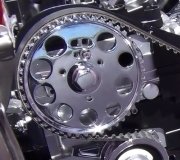This engine is a interference engine and if the timing belt breaks or jumps more than a couple of teeth may certainly damage the valves, pistons etc of the engine.
However I would assume the engine is bad yet until some checks are performed. For example a compression test should be performed first. Depending on the outcome of this test, the next step would be to remove the timing covers and manually inspect the timing belt for failure and correct timing. If the belt has jumped or is damaged, the next step will be to check for damaged valves. This can be done by manually closing the valves of the cylinder being inspected and then pressurizing the cylinder through the spark plug hole. While doing this you will be listening for air leakage. If air is heard coming from the intake manifold then this indicates intake valve damage, air flowing out of the exhaust indicates exhaust valve damage. (While doing this test you may need to rotate the camshaft to make sure the valves are in there closed position. If there is leakage no matter how much the cam is turned then there is valve damage.
Repeat this procedure for all the cylinders. If all the cylinders appear to be good. Go ahead and install a new timing belt. You may also want to install new cam and crank seals since they are known to leak and are located behind the timing belt. New timing belt tensioner and waterpump are also recommended.
SPONSORED LINKS
Wednesday, February 10th, 2010 AT 12:45 PM




